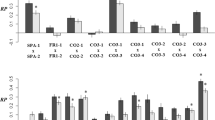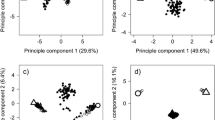Abstract
The fate of hybrids and the temporal and spatial dynamics of hybrid zones depend on hybrid fitness in comparison to non-hybrids. We studied cross-pollination among Hancornia speciosa varieties and compared progeny fitness in a nursery to address whether hybrid fitness differed from non-hybrids and whether maternal and paternal taxa contribute differentially to offspring fitness. This species has edible fruit pulp that is used as a raw material for candies, ice cream, and juice by small- and medium-sized enterprises in Central-West and Northeast Brazil. We genotyped 258 adults from a germplasm collection and 320 seeds using seven microsatellite loci to estimate genetic parameters and determine pollen donors. Fitness components, days to shoot, growth rate (mm/day), leaf width (mm), leaf length (mm), stem diameter (mm), and plant height (cm) were analyzed in 200 individuals. Genetic diversity and polymorphism did not differ neither between adults and progeny arrays nor among the four varieties. Genetic differentiation among varieties (F CT = 0.019, p < 0.001) and among populations within varieties (F SC = 0.053, p < 0.001) was significant but low. We detected mating among the four varieties, and no self-pollination was observed in parentage analysis, confirming that H. speciosa is self-incompatible with a high outcrossing rate (t m = 0.990, SE = 0.007). No significant effect of heterosis or exogamic depression was detected for any fitness component, but maternal contribution significantly affected plant height.


Similar content being viewed by others
References
Amorim JAE, Mata LR, Lédo AS, Azevedo VCR, Silva AVC (2015) Diversity and genetic structure of mangaba remnants in states of northeastern Brazil. Genet Mol Res 14:823–833
Austerlitz F, Smouse PE (2001) Two-generation analysis of pollen flow across a landscape. II. Relation between ϕFT, pollen dispersal and inter-females distance. Genetics 157:851–857
Azevedo VCR, Kanashiro M, Ciampi AY, Grattapaglia D (2007) Genetic structure and mating system of Manilkara huberi (Ducke) A. Chev., a heavily logged Amazonian timber species. J Hered 98:646–654
Barton NH, Hewitt GM (1985) Analysis of hybrid zones. Ann Rev Ecol Syst Evol 16:113–148
Barton NH, Hewitt GM (1989) Adaptation, speciation and hybrid zones. Nature 341:497–503
Buiteveld J, Bakker EG, Bovenschen J, Vries SMG (2001) Paternity analysis in a seed orchard of Quercus rubur L. and estimation of the amount of background pollination using microsatellite markers. For Genet 8:331–337
Burczyk J, Adams WT, Shimizu JY (1996) Mating patterns and pollen dispersal in a natural knobcone pine (Pinus attenuate Lemmon) stand. Heredity 77:251–260
Burczyk J, Lewandowski A, Chalupka W (2004) Local pollen dispersal and distant gene flow in Norway spruce (Picea abies [L.] Karst.). For Ecol Manage 197:39–48
Butlin R (1989) Reinforcement of premating isolation. In: Otte D, Endler JA (eds) Speciation and its consequences. Sinauer Associates Inc., Sunderland, pp 85–110
Casiva PV, Vilardi JC, Cialdella AM, Saidman BO (2004) Mating system and population structure of Acacia aroma and A. macracantha (Fabaceae). Am J Bot 91:58–64
Chaves LJ (2006) Recursos genéticos no Cerrado. In: Silva-Junior JF, Ledo AS (eds) A cultura da mangaba, 1st edn. Embrapa Tabuleiros Costeiros, Aracaju, pp 75–84
Coelho ASG, Valva FDO (2001) Processo evolutivo e o melhoramento de plantas. In: Nass LL, Valois ACC, Melo IS, Valadares-Inlis MC (eds) Recursos genéticos e melhoramento de plantas. Fundação MT, Rondonópolis, pp 58–78
Collevatti RG, Grattapaglia D, Hay JD (2001) High resolution microsatellite based analysis of the mating system allows the detection of significant biparental inbreeding in Caryocar brasiliense, an endangered tropical tree species. Heredity 86:60–67
Collevatti RG, Estolano R, Garcia SF, Hay JD (2010) Short-distance pollen dispersal and high self-pollination in a bat-pollinated neotropical tree. Tree Genet Genomes 6:555–564
Darrault RO, Schlindwein C (2005) Limited fruit production in Hancornia speciosa (Apocynaceae) and pollination by nocturnal and diurnal insects. Biotropica 37:381–388
Dobzhansky T (1970) Genetics of the evolutionary process. Columbia University Press, New York
Donohue K (2009) Completing the cycle: maternal effects as the missing link in plant life histories. Phil Trans R Soc B 364:1059–1074
Doyle JJ, Doyle JL (1987) A rapid DNA isolation procedure for small quantities of fresh leaf tissue. Phytochemical Bulletin 19:11–15
El-Kassaby YA, Askew GR (1998) Seed orchards and their genetics. In: Mandal AK, Gibson GL (eds) Forest genetics and tree breeding. CBS Publishers and Distributors, Daryaganj, New Delhi, pp 103–111
El-Kassaby YA, Lstiburek M (2009) Breeding without breeding. Genet Res 91:111–120
Feres JM, Guidugli MC, Mestriner MA, Sebbenn AM, Ciampi AY, Alzate-Marin AL (2009) Microsatellite diversity and effective population size in a germplasm bank of Hymenaea courbaril var. stilbocarpa (Leguminosae), an endangered tropical tree: recommendations for conservation. Genet Resour Crop Evol 56:797–807
Futuyma DJ, Shapiro LH (1995) Hybrid zones. Evolution 49:222–226
Gaino APSC, Silva AM, Moraes MA, Alves PF, Moraes MLT, Freitas MLM, Sebbenn AM (2010) Understanding the effects of isolation on seed and pollen flow, spatial genetic structure and effective population size of the dioecious tropical tree species Myracrodruon urundeuva. Conserv Genet 11:1631–1643
Ganga RMD, Chaves LJ, Naves RV (2009) Parâmetros genéticos em progênies de Hancornia speciosa Gomes do Cerrado. Scientia Forestalis 37:395–404
Ghazoul J (2005) Pollen and seed dispersal among dispersed plants. Biol Rev 80:413–443
Goudet J (2002) FSTAT, a program to estimate and test gene diversities and fixation indices (version 2.9.3.2). http://www.unil.ch/izea/softwares/fstat.html
Hewitt GM (1988) Hybrids zones—natural laboratories for evolutionary studies. Trends in Ecol Evol 3:158–167
Jiggins CD, Mallet J (2000) Bimodal hybrid zones and speciation. Trends in Evol Evol 15:250–255
Kalinowski ST, Taper ML, Marshall TC (2007) Revising how the computer program CERVUS accommodates genotyping error increases success in paternity assignment. Mol Ecol 16:1099–1106
Lederman IE, Bezzera JEF (2006) Situação atual e perspectivas da cultura. In: Silva-Junior JF, Ledo AS (eds) A cultura da mangaba, 1st edn. Embrapa Tabuleiros Costeiros, Aracaju, pp 247–253
Martins K, Chaves LJ, Buso GSC, Kageyama PY (2006) Mating system and fine-scale spatial genetic structure of Solanum lycocarpum St. Hil. (Solanaceae) in the Brazilian Cerrado. Conserv Genet 7:957–969
Monachino J (1945) A revision of Hancornia (Apocynaceae). Lilloa 11:19–48
Moriguchi Y, Taira H, Tani N, Tsumura Y (2004) Variation of paternal contribution in a seed orchard of Cryptomeria japonica determined using microsatellite markers. Can J For Res 34:1683–1690
Moura NF, Chaves LJ, Venkovsky R, Naves RV, Aguiar AV, Moura MF (2011) Genetic structure of mangaba (Hancornia speciosa Gomes) populations in the Cerrado region of Central Brazil. Biosci J 27:473–481
Mousadik A, Petit RJ (1996) High level of genetic differentiation for allelic richness among populations of the argan tree [Argania spinosa (L.) Skeels] endemic to Morocco. Theor Appl Genet 92:832–839
Murawski DA, Hamrick JL (1991) The effect of the density of flowering individuals on the mating systems of nine tropical tree species. Heredity 67:167–174
Nei M (1978) Estimation of average heterozygosity and genetic distance from a small number of individual. Genetics 89:583–590
Oosterhout CV, Hutchinson WF, Wills DPM, Shipley P (2004) MICRO-CHECKER: software for identifying and correcting genotyping errors in microsatellite data. Mol Ecol Notes 4:535–538
Paetkau D, Calvert W, Stirling I, Strobeck C (1995) Microsatellite analysis of population structure in Canadian polar bears. Mol Ecol 4:347–354
Ritland K (2002) Extensions of models for the estimation of mating systems using n independent loci. Heredity 88:221–228
Ritland K, Jain S (1981) A model for the estimation of outcrossing rate and gene frequencies using n independent loci. Heredity 47:35–52
Rodrigues AJL, Yamaguishi AT, Chaves LJ, Coelho ASG, Lima JS, Telles MPC (2015) Development of microsatellites markers for Hancornia speciosa gomes (Apocynaceae). Genet Mol Res 14:7274–7278
Rousset F (2008) Genepop’007: a complete re-implementation of the genepop software for Windows and Linux. Mol Ecol Resour 8:103–106
Seehausen O (2004) Hybridization and adaptive radiation. Trends Ecol Evol 19:198–207
Schluter D (2001) Ecology and the origin of species. Trends Ecol Evol 16:372–380
Smouse PE, Dyer RJ, Westfall RD, Sork VL (2001) Two generation analysis of pollen flow across a landscape. I. Male gamete heterogeneity among females. Evolution 55:260–271
Stoehr MU, Newton CH (2002) Evaluation of mating dynamics in a lodgepole pine seed orchard using chloroplast DNA markers. Can J For Res 32:469–476
Torimaru T, Wennstrom U, Lindgren D, Wang XR (2012) Effects of male fecundity, interindividual distance and anisotropic pollen dispersal on mating success in a Scots pine (Pinus sylvestris) seed orchard. Heredity 108:312–321
Weir BS (1996) Genetic data analysis II. Sinauer, Sunderland
Acknowledgments
This work was supported by the projects PRONEX CNPq/FAPEG/AUX PESQ CH 007/2009 and GENPAC10 CNPq/MCT/CAPES/FAPEG (project no. 563624/2010-8).
AMO received a scholarship from CAPES. RGC, MPCT, and LJC have continuously been supported by CNPq grants and scholarships whose assistance we gratefully acknowledge.
Data archiving statement
All data are provided as supplementary material in the online version of this article.
Author information
Authors and Affiliations
Corresponding author
Additional information
Communicated by D. Grattapaglia
Rights and permissions
About this article
Cite this article
Collevatti, R.G., Olivatti, A.M., Telles, M.P.C. et al. Gene flow among Hancornia speciosa (Apocynaceae) varieties and hybrid fitness. Tree Genetics & Genomes 12, 74 (2016). https://doi.org/10.1007/s11295-016-1031-x
Received:
Revised:
Accepted:
Published:
DOI: https://doi.org/10.1007/s11295-016-1031-x




